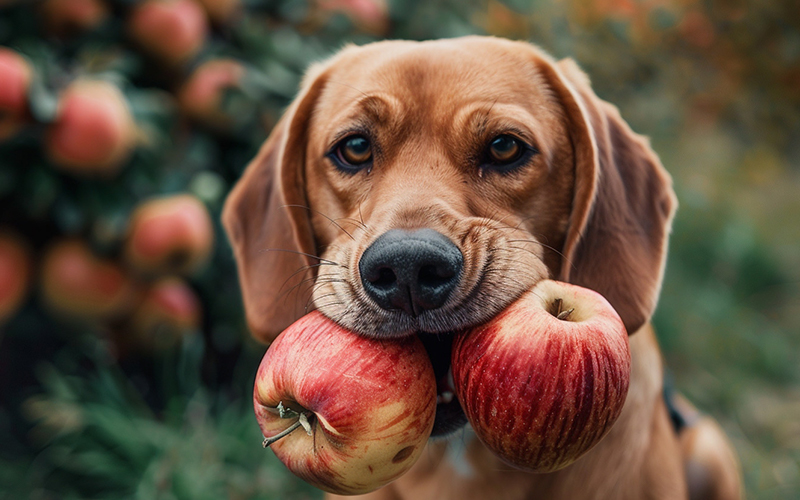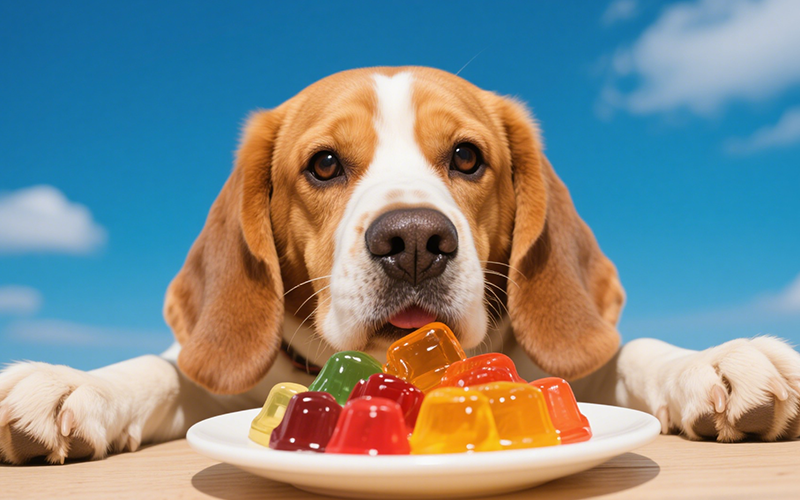Can Dogs Eat Apples? A Complete Guide to the Benefits and Risks
- 14 Feb 2025 15:34
As dog owners, we often look for healthy treats to give our pets, and fruits like apples might seem like an excellent option. Apples are delicious, nutritious, and widely available, but before you toss an apple slice to your dog, it’s important to understand whether they are safe for canine consumption.
So, can dogs eat apples? The short answer is yes, dogs can eat apples, but there are some precautions you should take. In this guide, we’ll explore the benefits and potential risks of feeding apples to dogs, how to prepare them, and how many apples are safe for your dog to enjoy.

Are Apples Safe for Dogs?
Yes, apples are safe for dogs to eat in moderation. Apples are a great low-calorie treat that can provide your dog with essential nutrients like fiber, vitamins, and antioxidants. They can be a healthy alternative to processed dog treats when given in the right amounts. However, there are a few things to keep in mind when offering apples to your dog.
Nutritional Benefits of Apples for Dogs
Apples are rich in nutrients that can support your dog’s overall health. Here’s a look at some of the key benefits:
Vitamins: Apples are a good source of Vitamin C, which is important for boosting your dog’s immune system and promoting healthy skin. They also contain Vitamin A, which supports eye health and vision.
Fiber: Apples are high in fiber, which can help regulate your dog’s digestive system. Fiber promotes healthy bowel movements and can assist in preventing constipation.
Antioxidants: Apples contain antioxidants, such as flavonoids and polyphenols, which can help reduce inflammation and combat oxidative stress in your dog’s body. This can contribute to overall cellular health.
Low in Fat and Calories: Apples are naturally low in fat and calories, making them an excellent treat for dogs that need to watch their weight. They provide a satisfying crunch and sweetness without contributing to unhealthy weight gain.
Hydration: Apples have a high water content, which can help keep your dog hydrated, especially on hot days or after exercise.
Potential Risks of Feeding Apples to Dogs
While apples can be a healthy treat for your dog, there are some important precautions you should take:
Seeds and Core: The most significant risk of feeding apples to dogs is the apple seeds and the core. Apple seeds contain amygdalin, a compound that can release cyanide when ingested in large quantities. While your dog would have to eat a significant amount of seeds to be at risk of cyanide poisoning, it’s still best to remove the seeds and core before offering apples to your dog.
Choking Hazard: The apple core itself can pose a choking hazard, especially for small dogs. Always slice the apple into manageable pieces, removing the core and seeds to make it safer for your dog to enjoy.
Allergic Reactions: Some dogs may be allergic to apples, although this is rare. Signs of an allergic reaction can include itching, swelling, vomiting, or diarrhea. If you notice any of these symptoms after your dog eats apples, stop feeding them to your pet and consult a health professional.
Overfeeding: While apples are healthy, they still contain sugar. Too many apples can lead to gastrointestinal upset, including diarrhea or bloating, especially in dogs with sensitive stomachs. Moderation is key when feeding your dog apples.
How to Serve Apples to Dogs
To ensure that your dog enjoys apples safely, follow these simple guidelines when serving them:
Remove the Core and Seeds: Before giving your dog any apple slices, make sure to remove the core and seeds. You can slice the apple into small, bite-sized pieces to make it easier for your dog to eat.
Serve Fresh: Fresh, raw apples are the best option for your dog. Avoid giving your dog canned apples or apples that have been processed with added sugar, preservatives, or artificial sweeteners.
Cut into Small Pieces: Depending on the size of your dog, cut the apple into small, manageable pieces to avoid choking hazards. Small dogs should only receive tiny bites, while larger dogs can handle bigger chunks.
Serve in Moderation: Like any treat, apples should be offered in moderation. A few small apple slices are a great occasional treat, but they should not replace a balanced, nutritionally complete dog food diet.
Frozen Apple Slices: For a cool treat on hot days, you can freeze apple slices and offer them to your dog. Frozen apples can be refreshing and fun for your dog to chew on, especially during the summer months.
How Many Apples Can Dogs Eat?
While apples are a healthy treat, they should be given in moderation. The exact number of apple slices a dog can safely consume will vary depending on their size and individual dietary needs. As a general guideline:
Small dogs: One or two small apple slices per day.
Medium-sized dogs: Two to three apple slices per day.
Large dogs: Three to five apple slices per day.
Remember, treats should not make up more than 10% of your dog’s daily caloric intake. If you’re unsure how many apples your dog can safely eat, consult a health professional to determine the right amount for your specific dog.
Conclusion
In conclusion, apples are a healthy and safe treat for most dogs when offered in moderation. They provide important nutrients like fiber, vitamins, and antioxidants, which can support your dog’s digestive health, immune system, and overall well-being. However, it’s important to remove the seeds and core, as these parts of the apple can be harmful to your dog.
As with any treat, it’s essential to offer apples as part of a balanced diet and in moderation. And always observe your dog for any signs of allergies or digestive upset when introducing new foods.
If you want a helpful tool to keep track of your dog’s health and ensure they stay on top of their wellness, consider using PettureX, a pet AI software. PettureX provides 24-hour online consultations and pet image recognition, helping you monitor your dog’s health and address concerns quickly. With PettureX by your side, you can ensure that your dog is always healthy and happy, no matter what tasty treats they enjoy.
By offering apples as an occasional, healthy treat and keeping an eye on portion sizes, you can keep your dog satisfied and safe while promoting their overall health.
Related

Can Dogs Eat Peaches? Vet Explains Benefits, Cyanide Risks & Safe Serving
- 16 Apr 2025
Can Dogs Eat Mulberries? Vet Explains Safety, Benefits & Potential Risks
- 16 Apr 2025
Can Dogs Eat Mozzarella? Vet Explains the Cheesy Truth (Risks & Benefits)
- 16 Apr 2025
Can Dogs Eat Mango Skin? Vet Explains Why It's a Risky Chew!
- 16 Apr 2025
Can Dogs Eat Maple Syrup? The Sugary Truth & Why Vets Advise Against It
- 16 Apr 2025
Can Dogs Eat Mac n Cheese? Vet Explains Why This Comfort Food Is Unsafe!
- 16 Apr 2025
Can Dogs Eat Liver? Vet Guide to This Nutrient-Dense Organ Meat (Benefits & Risks!)
- 16 Apr 2025
Can Dogs Eat Licorice? The Sweet Danger & Glycyrrhizin Risk Explained by Vets
- 16 Apr 2025
Can Dogs Eat Lamb? Vet Insights on This Nutritious Meat Option
- 16 Apr 2025
Can Dogs Eat Jelly? The Sweet Truth About Sugar, Xylitol & Why Vets Say No!
- 16 Apr 2025
